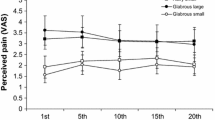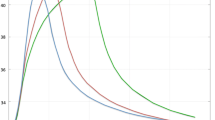Abstract
The objective of the present study was to examine the extent to which spatial summation (SS) of thermal senses is affected by skin type and skin thermal sensitivity. A total of 19 healthy subjects underwent measurements of warm- and cold-sensation threshold (WST and CST) with a large (9 cm2) and small (2.25 cm2) stimulation area, within the glabrous (palm) and hairy skin (dorsal surface) of the hand. SS of WST was also measured in warm-sensitive and warm-insensitive hairy skin sites. WST and CST significantly increased as stimulation area decreased (at a similar amount), in both hairy and glabrous skin. SS of CST in the glabrous skin was larger than that of hairy skin. A significant SS of WS existed in both warm-sensitive and warm-insensitive sites but the amount of SS was larger in warm-insensitive sites. Sex did not affect any of the factors tested. The similar amount of SS for WST and CST suggest that despite possible differences in receptor density, these two sub-systems share common features. Based on the stimulation areas used herein and on receptive-field (RF) sizes, SS of WST and CST appears to occur within RF of a single neuron. The larger magnitude of SS in the glabrous than hairy skin might suggest a larger integration of sensory information from the former, possibly due to a greater functional role of the palm.




Similar content being viewed by others
References
Andrew D, Craig AD (2001) Spinothalamic lamina I neurones selectively responsive to cutaneous warming in cats. J Physiol 537:489–495
Andrew D, Craig AD (2002) Quantitative responses of spinothalamic lamina I neurones to graded mechanical stimulation in the cat. J Physiol 545(Pt 3):913–931
Arendt-Nielsen L, Bjerring P (1988) Sensory and pain threshold characteristics to laser stimuli. J Neurol Neurosurg Psychiatr 51:35–42
Bradley RM (1995) Essentials of oral physiology. Bradley RM (ed) 2nd edn. Mosby, Missouri, pp 145–160
Campero M, Serra J, Bostock H, Ochoa JL (2001) Slowly conducting afferents activated by innocuous low temperature in human skin. J Physiol 535:855–865
Chen ACN, Niddama DM, Crawfordb HJ, Oostenveldc R, Arendt-Nielsen L (2002) Spatial summation of pain processing in the human brain as assessed by cerebral event related potentials. Neurosci Lett 328:190–194
Christensen BN, Perl ER (1970) Spinal neurons specifically excited by noxious or thermal stimuli: marginal zone of the dorsal horn. J Neurophysiol 33:293–311
Craig AD, Krout K, Andrew D (2001) Quantitative response characteristics of thermoreceptive and nociceptive lamina I spinothalamic neurons in the cat. J Neurophysiol 86:1459–1480
Defrin R, Urca G (1996) Spatial summation of heat pain: a reassessment. Pain 66:23–29
Defrin R, Givon R, Raz N, Urca G (2006) Spatial summation and spatial discrimination of heat pain. Pain 126:123–131
Dostrovsky JO, Craig AD (1996) Cooling-specific spinothalamic neurons in the monkey. J Neurophysiol 76:3656–3665
Dostrovsky JO, Hellon RF (1978) The representation of facial temperature in the caudal trigeminal nucleus of the cat. J Physiol 277:29–47
Duclaux R, Kenshalo SRDR (1980) Response characteristics of cutaneous warm receptors in the monkey. J Neurophysiol 43:1–15
Fruhstorfer H, Lindblom U, Schmidt WG (1976) Method for quantitative estimation of thermal thresholds in patients. J Neurol Neurosurg Psychiatr 39:1071–1075
Granovsky Y, Matre D, Sokolik A, Lorenz J, Casey KL (2005) Thermoreceptive innervation of human glabrous and hairy skin: a contact heat evoked potential analysis. Pain 115:238–247
Green BG, Cruz A (1998) “Warmth-insensitive fields”: evidence of sparse and irregular innervation of human skin by the warmth sense. Somatosens Mot Res 15:269–275
Green BG, Zaharchuk R (2001) Spatial variation in sensitivity as a factor in measurements of spatial summation of warmth and cold. Somatosens Mot Res 18:181–190
Hardy JD, Oppel TW (1937) Studies on temperature sensation. III. The sensitivity of the body to heat and the spatial summation of the end organ responses. J Clin Invest 16:533–540
Hardy JD, Oppel TW (1938) Studies in temperature sensation. IV. The stimulation of cold sensation by radiation. J Clin Invest 17:771–778
Hensel H (1969) Cutane Warmereceptoren bei Primaten. Pflügers Arch 818:150–152
Hensel H, Boman KKA (1960) Afferent impulses in cutaneous sensory nerves in human subjects. J Neurophysiol 23:564–578
Hensel H, Iggo A (1971) Analysis of cutaneous warm and cold fibres in primates. Pflügers Arch 329:1–8
Hensel H, Andres KH, Diiring MV (1974) Structure and function of cold receptors. Pflügers Arch 352:1–10
Herget CM, Hardy JD (1941) Temperature sensation: the spatial summation of heat. Am J Physiol 135:426–429
Herget CM, Granath LP, Hardy JD (1941) Warmth sense in relation to the area of skin stimulated. Am J Physiol 134:20–26
Holcberg G, Huleihel M, Katz M, Segal D, Sapir O, Mazor M, Malek A, Schneider H, Harrison JLK, Davis KD (1999) Cold-evoked pain varies with skin type and cooling rate: a psychophysical study in humans. Pain 83:123–135
Iannetti GD, Zambreanu L, Tracey I (2006) Similar nociceptive afferents mediate psychophysical and electrophysiological responses to heat stimulation of glabrous and hairy skin in humans. J Physiol 577:235–248
Iggo A (1969) Cutaneous thermoreceptors in primates and subprimates. J Physiol (Lond) 200:403430
Jacobs R, Wu CH, Goossens K, Van Loven K, Van Hees J, Van Steenberghe D (2002) Oral mucosal versus cutaneous sensory testing: a review of the literature. J Oral Rehabil 29:923–950
Kenshalo DR, Gallegos ES (1967) Multiple temperature-sensitive spots innervated by single nerve fibers. Science 158:1064–1065
Kojo I, Pertovaara A (1987) The effects of stimulus area and adaptation temperature on warm and heat pain thresholds in man. Int J Neurosci 32:875–880
Konietzny F, Hensel H (1977) The dynamic response of warm units in human skin nerves. Pflügers Arch 370:111–114
Krogstad AL, Elam M, Karlsson T, Wallin BG (1995) Arteriovenous anastomoses and the thermoregulatory shift between cutaneous vasoconstrictor and vasodilator reflexes. J Autonom Nervous Sys 53:215–222
LaMotte RH, Campbell JN (1978) Comparison of responses of warm and nociceptive C-fiber afferents in monkey with human judgments of thermal pain. J Neurophysiol 41:509–528
Marks LE, Stevens JC (1973) Spatial summation of warmth: influence of duration and configuration of the stimulus. Am J Psychol 86:251–267
Merzenich MM, Nelson RJ, Kaas JH, Stryker MP, Jenkins WM, Zook JM, Cynader MS, Schoppmann A (1987) Variability in hand surface representations in areas 3b and 1 in adult owl and squirrel monkeys. J Comp Neurol 258:281–296
Moss-Salentijn L (1992) The human tactile system. In: Nicholls HR (ed) Advanced tactile sensing for robotics and automated system, vol 5. World Scientific Publishing, Singapore, pp 123–150
Nouveau-Richard S, Monot M, Bastien P, De Lacharriere O (2004) In vivo epidermal thickness measurement: ultrasound vs confocal imaging. Skin Res Technol 10:136–140
Okamoto T, Iwase S, Sugenoya J, Mano T, Sugiyama Y, Yamamoto K (1994) Different thermal dependency of cutaneous sympathetic outflow to glabrous and hairy skin in humans. Eur J Appl Physiol Occup Physiol 68:460–464
Perl E (1968) Myelinated afferent fibres innervating the primate skin and their response to noxious stimuli. J Physiol (Lond) 197:593–615
Pons TP, Wall JT, Garraghty PE, Cusick CG, Kaas JH (1987) Consistent features of the hand in area 3b of macaque monkeys. Somatosens Res 4:309–331
Poulos DA, Lende RA (1970) Response of trigeminal ganglion neurones to thermal stimulation of oral-facial regions. 1. Steady state. J Neurophysiol 33:508–517
Stevens JC (1991) Thermal sensibility. In: Heller MA, Schiff W (eds) The psychology of touch. Lawrence Erlbaum, Hillsdale, pp 61–90
Stevens JC, Choo KK (1998) Temperature sensitivity of the body surface over the life span. Somatosens Mot Res 15:13–28
Stevens JC, Marks LE (1971) Spatial summation and the dynamics of warmth sensation. Percept Psychophys 9:291–298
Stevens JC, Marks LE (1979) Spatial summation of cold. Physiol Behav 22:541–547
Stevens JC, Marks LE, Simonson DC (1974) Regional sensitivity and spatial summation in the warmth sense. Physiol Behav 13:825–836
Sumino R, Dubner R, Starkman S (1973) Responses of small myelinated ‘warm’ fibers to noxious heat stimuli applied to the monkey’s face. Brain Res 62:260–263
Towell AD, Furvesaand AM, Boyda SG (1996) CO2 laser activation of nociceptive and non-nociceptive thermal afferents from hairy and glabrous skin. Pain 66:79–86
Treede RD, Meyer RA, Raja SN, Campbell JN (1995) Evidence for two different heat transduction mechanisms in nociceptive primary afferents innervating monkey skin. J Physiol 483:747–758
Willer JC, Boureau F, Berny J (1979) Nociceptive flexion reflexes elicited by noxious laser radiant heat in man. Pain 7:15–20
Yarnitsky D, Ochoa JL (1990) Studies of heat pain sensation in man: perception threshold, rate of stimulus rise and reaction time. Pain 40:85–91
Author information
Authors and Affiliations
Corresponding author
Rights and permissions
About this article
Cite this article
Defrin, R., Petrini, L. & Arendt-Nielsen, L. Spatial summation of thermal sensations depends on skin type and skin sensitivity. Exp Brain Res 198, 29–36 (2009). https://doi.org/10.1007/s00221-009-1934-y
Received:
Accepted:
Published:
Issue Date:
DOI: https://doi.org/10.1007/s00221-009-1934-y




